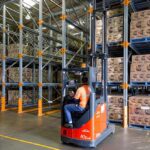When it comes to pallet racking, there’s a lot of choice in brand and type of racking. Obviously we think Colby pallet racking is the best, but beyond looking at brand it’s also important to consider what type of pallet racking is right for your business.
The most basic type of racking is selective pallet racking. Here pallets are stored on the racking one deep: i.e. every pallet is easily accessible via forklift. It’s a simple and easy way to stack pallets that works well for a lot of business. However, pallet racking can go so much further than this. A lot of business decide to just go with selective pallet racking, which is great, but they don’t explore other ways to store their pallets that may be more efficient.
Selectivity Versus Density
Most of the time when talking about pallet storage, you’re trading off selectivity and density. Having fast and easy access to each pallet (selectivity) usually means pallets can’t be stored as densely. Something as simple as double deep pallet racking puts half of the pallets being stored behind other pallets. While this can double the amount of pallets being stored in a warehouse, it means that half the pallets being stored aren’t easily accessible, which can be a draw back for some businesses.
Because of this, when choosing the right kind of pallet racking for your business, it’s important to assess how selective your storage needs to be and maximise the density based on how much selectivity can be sacrificed.
An easy example is a business that is storing a lot of pallets with the same SKU whose products aren’t perishable. In a situation like this, it doesn’t matter if a number of pallets aren’t accessible. Products of the same SKU can be stored double deep or more and, if they’re stored for a long time, it’s not an issue. Multi-deep storage is fine.
On the other side of this is storing pallets of many different SKUs with products that may perish. In this situation, it’s important to be able to get to every pallet, and simple selective pallet racking may be the best choice here.
Of course there are situations in the middle of these extremes and there’s general a pallet racking solution that suits it; whether that’s a specific kind of pallet racking or a mix of different types of racking to suit specific needs.
Stock Rotation and Speed
Connected to this is stock rotation and how quickly goods move through the warehouse. Some stock rotates quickly (or needs to rotate quickly); other stock doesn’t move as much. This can affect the type of racking being used and the density of storage.
Push back pallet racking, for example, is a fast storage method that allows for multi-deep pallet storage. This type of density may not be warranted for all products, especially if they’re not being rotated quickly, but it’s an option of a high density, high rotation storage. Similarly, a pallet life storage set up can be fairly dense while allowing for loading on one side of the racking and unloading on the other side. This is great for cross docking situations of for quick loading and unloading.
So, all in all, the type of pallet racking that should be used doesn’t just come down to the density needed, but also how the stock moves.
Talk To An Expert
If you’re unsure of what type of pallet racking is best for your business, get in touch with us today, we’re happy to give some advice and find the right pallet racking for your situation.




